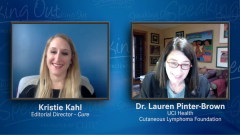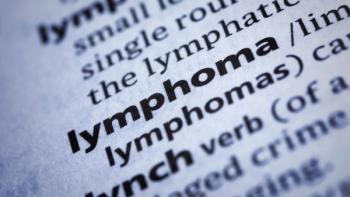
The Basics of Cutaneous T-Cell Lymphoma
Episodes in this series
Kristie L. Kahl: Can you explain what cutaneous T-cell lymphoma is and how it's different from B-cell lymphomas?
Dr. Lauren Pinter-Brown: Well, lymphomas are cancers that come from lymphocytes. And lymphocytes have two varieties: T and B. They can both cause cutaneous lymphomas. So cutaneous is a fancy word for skin. And cutaneous lymphomas are lymphomas that are primarily seen in skin. In the T-cell side of the skin, it is really common. The B-cell side not so much. But they look really different to somebody's eye as they look on the skin and they look very different to a pathologist.
Kristie L. Kahl: How is cutaneous T-cell lymphoma diagnosed?
Dr. Lauren Pinter-Brown: Mostly it's diagnosed by a skin biopsy. Occasionally it can be diagnosed by a special blood tests or by lymph node biopsies.
Kristie L. Kahl: What are some challenges that we still experience when it comes to diagnosing a patient, like the fact that it could mimic another skin condition, for example?
Dr. Lauren Pinter-Brown: The biggest problem is, number one, there has to be suspicion so that a biopsy is performed. Number two, the biopsy has to be performed really under optimum conditions, because it's kind of a subtle diagnosis. Sometimes if the biopsy is performed, and the skin has been treated with something like steroids, or they don't pick the best skin lesion, you won't get the diagnosis. And then third, it has to go to a pathologist that's really expert in reading cutaneous lymphomas, because often the diagnosis is there, but it's not really appreciated.
Kristie L. Kahl: Are there different types of hypopigmented variations of the disease that we have to worry about or look out for?
Dr. Lauren Pinter-Brown: Well, there's a lot of different variations of mycosis fungoides, which is the most common cutaneous T-cell lymphoma, both the way they appear to the doctor seeing the patient and the way they appeared to a pathologist. So, you mentioned hypopigmented mycosis fungoides. That's one of the kinds of variations that you would see that looks really different and sometimes it's treated a little differently.
Kristie L. Kahl: How does the disease differ in children?
Dr. Lauren Pinter-Brown: Children are expected to have a similar course, but children will often present with hypopigmented mycosis fungoides. And they're treated with light therapy often. And now they're thought to do the same as adults, which is, in the most part, very, very well.
Kristie L. Kahl: Okay, and so I know obviously this can be seen on the skin, but it's a type of cancer. So when a person does receive a diagnosis, what type of health care provider or physician should they be seeing for their care?
Dr. Lauren Pinter-Brown Well, that's always such a big question. Do you go to a dermatologist? Or do you go to an oncologist? And my answer is you go to somebody that has familiarity with this condition. So, I happen to be an oncologist who's interested in skin lymphomas, which is a little bit unusual. And I'm joined by colleagues in dermatology all the time. So, some places will have a team to use the expertise of both individuals. And in some places, maybe not, but people should be cared for by someone that actually understands this condition and had some experience with it, no matter what their subspecialty is.
Kristie L. Kahl: Can you go into what the multidisciplinary approach looks like for patients?
Dr. Lauren Pinter-Brown: Well, I'm sure it varies by the institution. A dermatologist would be specifically expert in helping with the skin problems, not necessarily just the cancer itself, but other disorders that the person might have on their skin, supportive care for their skin. An oncologist is probably most expert in systemic treatments. The pathologist we have to have because without a biopsy and a diagnosis, we don't know what to treat. And, and I would say that some other members of the team might include radiologists that read people's scans, or radiation therapists who we might ask for help for radiating particular lesions.
Kristie L. Kahl: How do can patients learn more about their care so that way we can ensure that they're being treated by the right team of health care providers?
Dr. Lauren Pinter-Brown: Well, one good resource for patients is the Cutaneous Lymphoma Foundation. There's a lot of resources for patients educationally. And in addition, the foundation maintains a list, if you will, of places that have a specific interest in skin lymphomas. I suppose another place to look, though it's more geared for healthcare professionals, is something that's called NCCN. It's an organization of National Comprehensive Cancer Centers. And they have recommendations, very general ones for cutaneous lymphoma. And not only health care providers can log on, but patients as well. It doesn't cost anything. So, it's another resource for learning.





